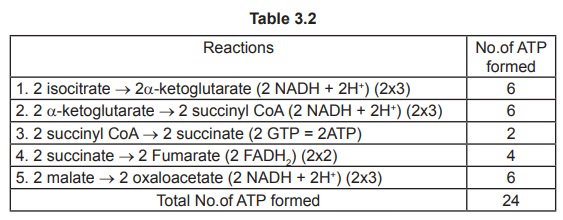Chapter: Biochemistry: Carbohydrate Metabolism
Tricarboxylic acid cycle (TCA cycle)
Tricarboxylic acid cycle (TCA cycle)
This cycle is the aerobic phase of carbohydrate
metabolism and follows the anaerobic pathway from the stage of pyruvate and is
called as citric acid cycle or TCA cycle. The name citric acid cycle stems from
citric acid which is formed in the first step of this cycle. This cycle is also
named "Kerbs cycle" after H.A. Krebs, an English biochemist who
worked on it.
Under aerobic conditions, pyruvate is
oxidatively decarboxylated to acetyl coenzyme A (active acetate) before
entering the citric acid cycle. This occurs in the mitochondrial matrix and forms
a link between glycolysis and TCA cycle.

PDH-pyruvate dehydrogenase
This reaction is catalysed by the multienzyme
complex known as pyruvate dehydrogenase complex.

Reactions of the citric acid cycle
There are eight steps in the cycle and the
reactions are as follows.
1. Formation of citrate
The first reaction of the cycle is the
condensation of acetyl CoA with oxaloacetate to form citrate, catalyzed by
citrate synthase. This is an irreversible reaction.

2. Formation of isocitrate via cis aconitate
The enzyme aconitase catalyzes the reversible
transformation of citrate to isocitrate, through the intermediary formation of
cis aconitate.

3. Oxidation of isocitrate to a-ketoglutarate and CO2
In the next step, isocitrate dehydrogenase
catalyzes oxidative decarboxylation of isocitrate to form a-ketoglutarate.

4. Oxidation of a-keto glutarate to succinyl CoA and CO2
The next step is another oxidative
decarboxylation, in which a-ketoglutarate is converted to succinyl CoA and CO2
by the action of the a-ketoglutarate dehydrogenase complex. The reaction is
irreversible.

5. Conversion of succinyl CoA to succinate
The product of the preceding step, succinyl CoA
is converted to succinate to continue the cycle. GTP is formed in this step
(substrate level phosphorylation).

The enzyme that catalyzes this reversible
reaction is called succinyl CoA synthetase or succinic thiokinase.
6. Oxidation of succinate to fumarate
The succinate formed from succinyl CoA is
oxidized to fumarate by the enzyme succinate dehydrogenase

7. Hydration of fumarate to malate
The reversible hydration of fumarate to malate
is catalyzed by fumarase.

8. Oxidation of malate to oxaloacetate
The last reaction of the citric acid cycle is,
NAD linked malate - dehydrogenase which catalyses the oxidation of malate to
oxaloacetate.

Energy yield from TCA cycle
If one molecule of the substrate is oxidized
through NADH in the electron transport chain three molecules of ATP will be
formed and through FADH2, two ATP molecules will be generated.
As one molecule of glucose gives rise to two
molecules of pyruvate by glycolysis, intermediates of citric acid cycle also
result as two molecules.

Related Topics